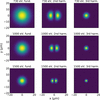issue contents
July 2023 issue

Cover illustration: X-ray linear dichroism of boron nitride nanobamboos measured at the B-edge – 192 eV (top left) and N-edge – 403 eV (top right) by soft X-ray ptychography (see Vijayakumar, Yuan, Mille, Stanescu, Swaraj, Favre-Nicolin, Najafi, Hitchcock and Belkhou, pages 746–757). The image sequence corresponds to the ptychography amplitude (bottom left) and phase (bottom right) images from 191.1 to 192.9 eV.
facility information
research papers
Open  access
access
 access
accessMeasurements of the transmission as well as the contribution of harmonic radiation at the soft X-ray beamline of the Small Quantum Systems instrument at the SASE3 undulator of European XFEL are presented.
Open  access
access
 access
accessA MHz X-ray diffraction set-up for the investigation of material behaviour under dynamic compression in a diamond anvil cell at intermediate strain rates has been developed at the High Energy Density (HED) instrument at the European XFEL.
Open  access
access
 access
accessThe thermal deformation requirement for wavefront preservation through an X-ray crystal monochromator is found to restrict the standard deviation of the height error to less than 25 pm under certain conditions. By optimizing the effective cooling temperature of liquid-nitrogen-cooled crystals, combined with compensation of the second-order component of the thermal deformation, an approach to reach this unprecedented requirement is described.
Open  access
access
 access
accessSince August 2021, the French synchrotron light source SOLEIL has been running with a 1 m-long permanent-magnet dipole producing a magnetic field of 2.8 T. This is a major modification of the storage ring that allows the high-energy photon flux for the ROCK beamline to be increased and significantly improves the resolution for experiments performed above 20 keV.
Open  access
access
 access
accessThe surface figure of an X-ray mirror has been corrected by differential deposition of WSi2 films.
Open  access
access
 access
accessA compact gas attenuator for the SwissFEL ATHOS beamline with a custom manifold realized using additive manufacturing is described. First results show that the response is as expected from theoretical calculations.
Open  access
access
 access
accessA presentation of how EIGER2 detectors work and how to best use their newly released features for fast image acquisitions and advanced acquisition schemes.
Open  access
access
 access
accessThe convolutional multiple whole profile fitting method of X-ray line profile analysis using synchrotron radiation allows the experimental determination of dislocation densities separately for different Burgers vectors up to a high degree of deformation. Its reliability for Mg–Zn–Y alloys, in terms of the dislocation activity during tensile deformation, has been successfully verified by combined analysis with electron backscatter diffraction investigation and visco-plastic self-consistent simulation.
Open  access
access
 access
accessFirst B-edge (192 eV) soft X-ray ptychography, challenges related to weak scattering, measurement approaches and reconstructions in energies as low as 180 eV are discussed.
Open  access
access
 access
accessThe local structure of titania–ceria composites in a Gd-doped ceria solid electrolyte material is obtained by a combination of X-ray absorption fine structure and X-ray diffraction over the entire range of Ti composition. A compositional region (between 19 and 57%) with strongly distorted TiO6 units and coexistence of Ce(III) and Ce(IV) was discovered, i.e. optimized for oxygen transport conduction and in agreement with the enhanced electro-chemo-mechanical effect previously observed in this composition range.
Open  access
access
 access
accessA model of an X-ray photoelectron spectroscopy experiment accounting for photon beam asperities, sample geometry and kinetic energy analyzer is introduced. This model is related via the alignment parameter to a simple model commonly used for data interpretation. An alignment parameter estimation method is introduced and tested with simulated and experimental data.
Open  access
access
 access
accessSynchrotron-sourced radiation-driven internalization and localization of nanospheres inside mammalian cells.
Open  access
access
 access
accessMicropipette aspiration has been combined with a windowless hydrated sample environment for single-particle X-ray analysis. A water droplet serves as a `chamber', covered by a mineral oil to prevent evaporation. In the droplet, particles can be aspirated and manipulated by one or two micropipettes. The system was evaluated on two undulator beamlines, using grains, giant lipid vesicles, colloids and macrophages as test objects. Holographic near-field images were recorded.
Open  access
access
 access
accessA workflow for orienting and mapping nanocrystals on a substrate of a different material lattice using scanning Laue diffraction microscopy has been established.
short communications
Open  access
access
 access
accessResearch in high-pressure devices, such as the diamond anvil cell and the large volume press, requires knowledge of the pressure and temperature in the sample. Here, a large volume press and an internal resistive heater were used to generate high load and heat to various combinations of intimately mixed powders of materials. X-ray diffraction and custom software were used to jointly estimate the pressures and temperatures in the samples and establish calibrants for in situ experiments at extreme conditions.
beamlines
Open  access
access
 access
accessA demonstration of full-field hard X-ray nano-tomography for high- and low-Z material samples is presented for the two TXM resolution modes developed at beamline BL18B at SSRF.
Open  access
access
 access
accessThe implementation of a von Hámos spectrometer for diamond anvil cell experiments at the High Energy Density Instrument of the EuXFEL is described.
Open  access
access
 access
accessA new versatile beamline for experiments with soft X-ray absorption, photoelectron emission and electron–ion coincidence spectroscopies is available at MAX IV Laboratory, Sweden, serving user communities from ultra-high-vacuum surface science to materials science and low-density matter research.
Download citation


Download citation


Open  access
access
 access
accessA new high-pressure single-crystal diffraction setup has been designed and implemented at the Australian Synchrotron for collecting molecular and protein crystal structures.
Open  access
access
 access
accessBasic information about beamline BL1N2, the effect of ageing by synchrotron radiation to suppress mirror contamination, and efforts to support industrial use are reported.
addenda and errata
Open  access
access
 access
accessobituaries
Open  access
access
 access
access
 journal menu
journal menu










































